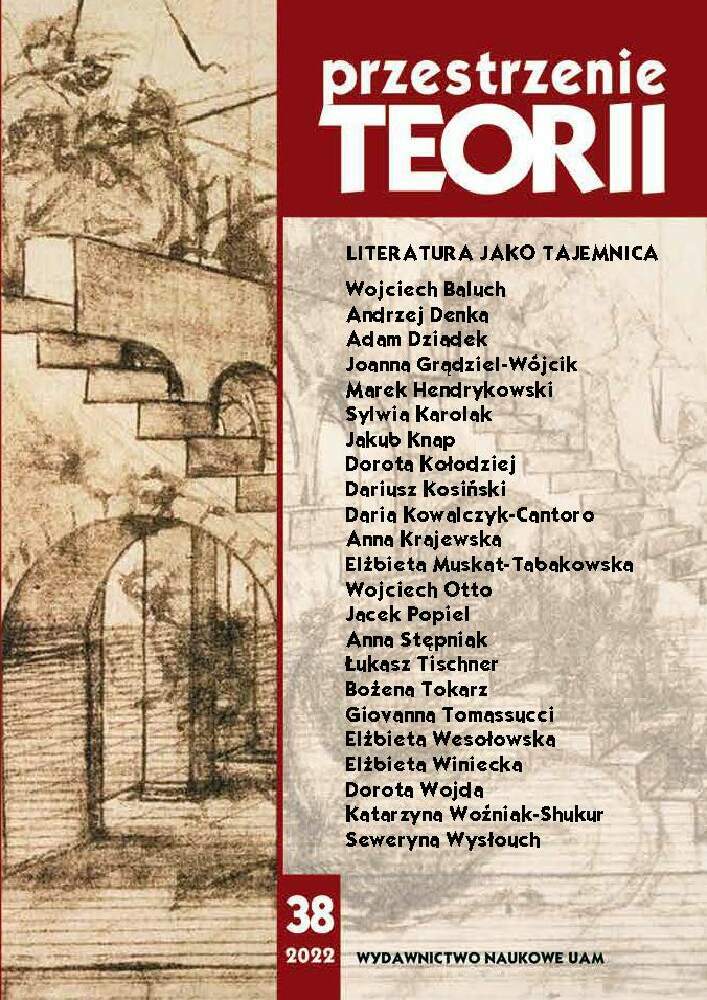Abstract
The paper attempts to introduce Polish readers to a theory presented by the American literary scholar Margaret Freeman in her recent book, The Poem as Icon (2020). In the monograph, Freeman analyzes ways in which the reader experiences reality – both visible and invisible – through poetry. Her fundamental assumption is that the relevant research question is not what literary art is, but how it comes to be what it is. The purpose of the present paper is to show that, although written by a literary scholar, the monograph corresponds to general tendencies that can be seen in contemporary humanities: in cognitive linguistics (in particular, Leonard Talmy’s theory of -ception and George Lakoff’s cognitive theory of metaphor), in the theory of linguistic picture of the world, or in discourse analysis. All these disciplines are based upon the assumption that the essence of the world is continuous change, and they investigate linguistic expressions in the process of becoming, which is relative to factors traditionally considered as non-linguistic. Freeman’s poetic cognition has a wide scope: it embraces cognitive processes of human mind, but also bodily and emotive cognition. Thus poetic cognition is embodied, and in Freemen’s theory a “poem-as-icon” ultimately becomes an illusion of the “here-and-now” direst experience.
References
Bojarska K., Poczuć myślenie: afektywne procedury historii i krytyki (dziś), „Teksty Drugie” 2013, 6, s. 8–16.
Fauconnier G., Mental Spaces, Cambridge 1985.
Fischer O., Nänny M., Introduction: Iconicity as a Creative Force in Language Use, [w:] Form miming meaning, red. M. Nänny, O. Fischer, Amsterdam–Philadelphia 1999, s. xv–xxxvi.
Freeman M.H., Przekraczanie granic czasu: fenomenologia Merleau-Ponty’ego a teorie językoznawstwa kognitywnego, przeł. M. Majewska, „Przestrzenie Teorii” 2007 [2004], 8, s. 223–234.
Freeman M.H., The Poem as Icon, Oksford 2020.
Hiraga M., Metaphor and Iconicity. A Cognitive Approach to Analyzing Texts, Londyn 2005.
Johnson M., The Body in the Mind: The Bodily basis of Meaning, Imagination and Reason, Chicago 1987.
Kövecses Z., A New Look at Metaphorical Creativity in Cognitive Linguistics, „Cognitive Linguistics” 2010, 21.4, s. 663–697.
Kövecses Z., Extended Conceptual Metaphor Theory, Cambridge 2020.
Kruse F.E., Is Music a Pure Icon?, „Transactions of the Charles S. Peirce Society” 2007, 43/4, s. 626–635 (review of T.L. Short).
Lakoff G., Johnson M., Metafory w naszym życiu, przeł. T.P. Krzeszowski, Warszawa 1988 [1981].
Langacker R.W., Gramatyka kognitywna. Wprowadzenie, przekład zbiorowy, Kraków 2009 [2008].
Merleau-Ponty M., Widzialne i niewidzialne, przeł. M. Kowalska, Warszawa 1996.
Newen A. (1946) 1996, [w:] The Oxford Handbook of 4E Cognition, red. A. Newen, Sh. Gallagher, L. De Bruin, Oxford 2018.
Noth W., Icon and Iconicity, [w:] Handbook od Semiotics, Bloomington and Indianapolis 1995, s. 121–128.
Short T.L., Peirce’s Theory of Signs, Cambridge 2009 (2007).
Stockwell P., Cognitive Poetics, Londyn 2019 (2002).
Stockwell P., Poetyka kognitywna. Wprowadzenie, przeł. A. Skucińska, Kraków 2002.
Talmy L., Fictive motion in language and „ception”, [w:] Toward a Cognitive Semantics, Cambridge 2000, s. 99–176.
Ungerer F., Diagrammatic Iconicity in Word-Formation, [w:] Form miming meaning, red. M. Nänny, O. Fischer, Amsterdam–Philadelphia 1999, s. 308–324.
License

This work is licensed under a Creative Commons Attribution-NonCommercial-NoDerivatives 4.0 International License.
Authors
Authors of texts accepted for publication in Przestrzenie Teorii are required to complete, sign and return to the editor's office the Agreement for granting a royalty-free license to works with a commitment to grant a CC sub-license.
Under the agreement, the authors of texts published in Przestrzenie Teorii grant the Adam Mickiewicz University in Poznań a non-exclusive, royalty-free license and authorize the use of Attribution-NonCommercial-NoDerivatives 4.0 International (CC BY-NC-ND 4.0) Creative Commons sub-license.
The authors retain the right to continue the free disposal of the work.
Users
Interested Internet users are entitled to use works published in Przestrzenie Teorii since 2015, for non-commercial purposes only, under the following conditions:
- attribution - obligation to provide, together with the distributed work, information about the authorship, title, source (link to the original work, DOI) and the license itself.
- no derivatives - the work must be preserved in its original form, without the author's consent it is not possible to distribute the modified work, such as translations, publications, etc.
Copyrights are reserved for all texts published before 2015.
Miscellaneous
Adam Mickiewicz University in Poznań retains the right to magazines as a whole (layout, graphic form, title, cover design, logo etc.).

